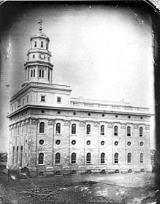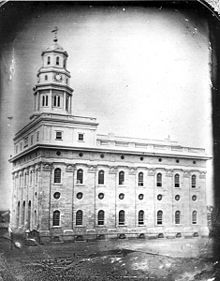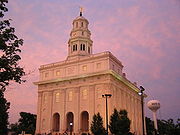
William Weeks
Encyclopedia
William Weeks was the first church architect
of the Church of Jesus Christ of Latter Day Saints, and is best known as the architect of the Nauvoo Temple
.
Weeks was the son of James Weeks, Jr., and Sophronia Fisher and was born on March 11, 1813 in Martha’s Vineyard, Massachusetts
. He came from a family of builders; his father taught architectural and building skills to his two sons, William and Arwin. Raised as a Quaker, Weeks converted to Mormonism
in the southeastern states. Apparently, he was in Missouri
when the Mormons were driven from that state during the winter of 1838–1839, and he settled in Quincy
, Illinois
. There on June 11, 1839 he married Caroline M. Allen, who was ten years his junior. Their marriage lasted sixty-one years and produced ten children, seven of whom died in early infancy.
 In 1840 Weeks relocated to Nauvoo
In 1840 Weeks relocated to Nauvoo
, where he built a new brick home, which still stands. When Joseph Smith, Jr., called for architects to submit designs for the Nauvoo Temple, he was so impressed with Weeks' drawings that he hugged him, exclaiming, “You are the man I want!” While Weeks was the temple’s architect, final decisions about the building design were made by Smith, who overruled Weeks on occasions. Most famous is Smith’s insistence that circular windows, instead of oval, be used in the temple, although Weeks insisted that such windows were a violation of all known rules of architecture. Smith did not extend such latitude over Weeks to others. When the Temple Building Committee got into an argument with Weeks, Smith prepared a certificate for Weeks that stated that “no person or persons shall interfere with him or his plans in building the temple.” When Smith was killed in June 1844, Brigham Young
assumed Smith’s role as the church’s leader, which included oversight of the temple’s construction; Young even made his own changes to Smith’s design. Weeks did not see the temple completed, because Young insisted that he accompany the Mormon migration west so that he could design a new temple when the Mormons found a place to settle. On February 13, 1846, Brigham Young turned the final completion of the Nauvoo Temple over to Truman O. Angell
.
bricoleurs, a term defined by Thomas Hubka:
Hubka argued that a bricoleur’s design strategy involves the unremitting practice of “composition and decomposition within a vocabulary of existing building forms.” The resulting architecture constitutes a reorganization of the “hierarchy of ideas (schemata)” included within the stylistic customs and techniques of existing buildings. The Nauvoo temple is a classic experiment in bricolage and by decomposing traditional architectural language with which he was familiar, Weeks created a novel material response to shifting theological and ritual practices.
and Iowa
. While in Iowa, he learned of Nauvoo Temple’s arson. He returned to Utah
in 1852, apparently seeking reconciliation and reinstallation as the architect for the Salt Lake Temple. However, Young used Angell as the architect of the building. After his work as architect on the Nauvoo Temple, Weeks never worked as an architect again. By 1857 he had settled in San Bernardino
, California
, where he severed all contact with the LDS Church, although he remained an admirer of Joseph Smith all his life. He stayed in California the rest of his life.
, where he worked as a carpenter
and later ran a gristmill
for a Mr. Temple. He purchased a herd of cows and opened a 160 acre (0.6474976 km²) dairy
in Hollywood, providing milk
to Los Angeles
groceries. He later moved the dairy to Green Meadow, six miles north of Los Angeles. When he became too old to run the dairy, he purchased a small ranch
and built a house in Palms
, where he and Caroline lived the rest their lives. Weeks died on March 8, 1900.
 Weeks’ drawings of the Nauvoo Temple remained with his descendants, passing from Weeks to his daughter Caroline F. Weeks Griffin, who passed them to her son, Leslie Griffin. In 1948 two Mormon missionaries
Weeks’ drawings of the Nauvoo Temple remained with his descendants, passing from Weeks to his daughter Caroline F. Weeks Griffin, who passed them to her son, Leslie Griffin. In 1948 two Mormon missionaries
, Frank Gifford and Vern Thacker, contacted Griffin while tracting door to door in Boron
, California. Griffin and the two missionaries became friends, and, when Griffin learned that Thacker was returning to Salt Lake City, he gave him Weeks' drawings to donate to the LDS Church. Thacker did as Griffin requested, and Weeks’ original drawings proved invaluable in the later reconstruction of the Nauvoo Illinois Temple
.
Architect
An architect is a person trained in the planning, design and oversight of the construction of buildings. To practice architecture means to offer or render services in connection with the design and construction of a building, or group of buildings and the space within the site surrounding the...
of the Church of Jesus Christ of Latter Day Saints, and is best known as the architect of the Nauvoo Temple
Nauvoo Temple
The Nauvoo Temple was the second temple constructed by the Church of Jesus Christ of Latter Day Saints, commonly known as the Mormons. The church's first temple was completed in Kirtland, Ohio, United States in 1836. When the main body of the church was forced out of Nauvoo, Illinois in the...
.
Weeks was the son of James Weeks, Jr., and Sophronia Fisher and was born on March 11, 1813 in Martha’s Vineyard, Massachusetts
Massachusetts
The Commonwealth of Massachusetts is a state in the New England region of the northeastern United States of America. It is bordered by Rhode Island and Connecticut to the south, New York to the west, and Vermont and New Hampshire to the north; at its east lies the Atlantic Ocean. As of the 2010...
. He came from a family of builders; his father taught architectural and building skills to his two sons, William and Arwin. Raised as a Quaker, Weeks converted to Mormonism
Mormonism
Mormonism is the religion practiced by Mormons, and is the predominant religious tradition of the Latter Day Saint movement. This movement was founded by Joseph Smith, Jr. beginning in the 1820s as a form of Christian primitivism. During the 1830s and 1840s, Mormonism gradually distinguished itself...
in the southeastern states. Apparently, he was in Missouri
Missouri
Missouri is a US state located in the Midwestern United States, bordered by Iowa, Illinois, Kentucky, Tennessee, Arkansas, Oklahoma, Kansas and Nebraska. With a 2010 population of 5,988,927, Missouri is the 18th most populous state in the nation and the fifth most populous in the Midwest. It...
when the Mormons were driven from that state during the winter of 1838–1839, and he settled in Quincy
Quincy, Illinois
Quincy, known as Illinois' "Gem City," is a river city along the Mississippi River and the county seat of Adams County. As of the 2010 census the city held a population of 40,633. The city anchors its own micropolitan area and is the economic and regional hub of West-central Illinois, catering a...
, Illinois
Illinois
Illinois is the fifth-most populous state of the United States of America, and is often noted for being a microcosm of the entire country. With Chicago in the northeast, small industrial cities and great agricultural productivity in central and northern Illinois, and natural resources like coal,...
. There on June 11, 1839 he married Caroline M. Allen, who was ten years his junior. Their marriage lasted sixty-one years and produced ten children, seven of whom died in early infancy.
The Nauvoo Temple

Nauvoo, Illinois
Nauvoo is a small city in Hancock County, Illinois, United States. Although the population was just 1,063 at the 2000 census, and despite being difficult to reach due to its location in a remote corner of Illinois, Nauvoo attracts large numbers of visitors for its historic importance and its...
, where he built a new brick home, which still stands. When Joseph Smith, Jr., called for architects to submit designs for the Nauvoo Temple, he was so impressed with Weeks' drawings that he hugged him, exclaiming, “You are the man I want!” While Weeks was the temple’s architect, final decisions about the building design were made by Smith, who overruled Weeks on occasions. Most famous is Smith’s insistence that circular windows, instead of oval, be used in the temple, although Weeks insisted that such windows were a violation of all known rules of architecture. Smith did not extend such latitude over Weeks to others. When the Temple Building Committee got into an argument with Weeks, Smith prepared a certificate for Weeks that stated that “no person or persons shall interfere with him or his plans in building the temple.” When Smith was killed in June 1844, Brigham Young
Brigham Young
Brigham Young was an American leader in the Latter Day Saint movement and a settler of the Western United States. He was the President of The Church of Jesus Christ of Latter-day Saints from 1847 until his death in 1877, he founded Salt Lake City, and he served as the first governor of the Utah...
assumed Smith’s role as the church’s leader, which included oversight of the temple’s construction; Young even made his own changes to Smith’s design. Weeks did not see the temple completed, because Young insisted that he accompany the Mormon migration west so that he could design a new temple when the Mormons found a place to settle. On February 13, 1846, Brigham Young turned the final completion of the Nauvoo Temple over to Truman O. Angell
Truman O. Angell
Truman Osborn Angell served many years as Church Architect for The Church of Jesus Christ of Latter-day Saints, and was a member of the vanguard company of Mormon pioneers, entering the Salt Lake Valley on July 24, 1847. He designed the Salt Lake Temple, the Lion House, the Beehive House, the...
.
Weeks, the Architect
Weeks can be grouped into the larger general category of vernacular designers orbricoleurs, a term defined by Thomas Hubka:
Folk builders are not often given the status of architectural designers. This is unfortunate because folk builders have rigorous, highly structured design methods for generating and refining spatial form. Although folk design methods differ from those employed by modern architectural designers, their object is the same – the conversion of ideas into spatial form.
Hubka argued that a bricoleur’s design strategy involves the unremitting practice of “composition and decomposition within a vocabulary of existing building forms.” The resulting architecture constitutes a reorganization of the “hierarchy of ideas (schemata)” included within the stylistic customs and techniques of existing buildings. The Nauvoo temple is a classic experiment in bricolage and by decomposing traditional architectural language with which he was familiar, Weeks created a novel material response to shifting theological and ritual practices.
Disaffection with Mormonism
Weeks arrived in Salt Lake City in September 1847. He soon became disaffected with the church, and took his family east the next summer, taking all of the Nauvoo Temple plans with him. For a time Weeks settled in WisconsinWisconsin
Wisconsin is a U.S. state located in the north-central United States and is part of the Midwest. It is bordered by Minnesota to the west, Iowa to the southwest, Illinois to the south, Lake Michigan to the east, Michigan to the northeast, and Lake Superior to the north. Wisconsin's capital is...
and Iowa
Iowa
Iowa is a state located in the Midwestern United States, an area often referred to as the "American Heartland". It derives its name from the Ioway people, one of the many American Indian tribes that occupied the state at the time of European exploration. Iowa was a part of the French colony of New...
. While in Iowa, he learned of Nauvoo Temple’s arson. He returned to Utah
Utah
Utah is a state in the Western United States. It was the 45th state to join the Union, on January 4, 1896. Approximately 80% of Utah's 2,763,885 people live along the Wasatch Front, centering on Salt Lake City. This leaves vast expanses of the state nearly uninhabited, making the population the...
in 1852, apparently seeking reconciliation and reinstallation as the architect for the Salt Lake Temple. However, Young used Angell as the architect of the building. After his work as architect on the Nauvoo Temple, Weeks never worked as an architect again. By 1857 he had settled in San Bernardino
San Bernardino, California
San Bernardino is a city located in the Riverside-San Bernardino metropolitan area , and serves as the county seat of San Bernardino County, California, United States...
, California
California
California is a state located on the West Coast of the United States. It is by far the most populous U.S. state, and the third-largest by land area...
, where he severed all contact with the LDS Church, although he remained an admirer of Joseph Smith all his life. He stayed in California the rest of his life.
Later life
Weeks did not pursue work as an architect in California, but moved to El MonteEl Monte, California
El Monte is a residential, industrial, and commercial city in Los Angeles County, California, United States. The city's slogan is "Welcome to Friendly El Monte," and historically is known as "The End of the Santa Fe Trail." As of the 2010 census, the city had a total population of 113,475,...
, where he worked as a carpenter
Carpenter
A carpenter is a skilled craftsperson who works with timber to construct, install and maintain buildings, furniture, and other objects. The work, known as carpentry, may involve manual labor and work outdoors....
and later ran a gristmill
Gristmill
The terms gristmill or grist mill can refer either to a building in which grain is ground into flour, or to the grinding mechanism itself.- Early history :...
for a Mr. Temple. He purchased a herd of cows and opened a 160 acre (0.6474976 km²) dairy
Dairy
A dairy is a business enterprise established for the harvesting of animal milk—mostly from cows or goats, but also from buffalo, sheep, horses or camels —for human consumption. A dairy is typically located on a dedicated dairy farm or section of a multi-purpose farm that is concerned...
in Hollywood, providing milk
Milk
Milk is a white liquid produced by the mammary glands of mammals. It is the primary source of nutrition for young mammals before they are able to digest other types of food. Early-lactation milk contains colostrum, which carries the mother's antibodies to the baby and can reduce the risk of many...
to Los Angeles
Los Ángeles
Los Ángeles is the capital of the province of Biobío, in the commune of the same name, in Region VIII , in the center-south of Chile. It is located between the Laja and Biobío rivers. The population is 123,445 inhabitants...
groceries. He later moved the dairy to Green Meadow, six miles north of Los Angeles. When he became too old to run the dairy, he purchased a small ranch
Ranch
A ranch is an area of landscape, including various structures, given primarily to the practice of ranching, the practice of raising grazing livestock such as cattle or sheep for meat or wool. The word most often applies to livestock-raising operations in the western United States and Canada, though...
and built a house in Palms
Palms, Los Angeles, California
Palms is a community founded in 1886 in West Los Angeles, California, and was the oldest neighborhood annexed to the city of Los Angeles, in 1915. The 1886 tract was marketed as an agricultural and vacation community...
, where he and Caroline lived the rest their lives. Weeks died on March 8, 1900.
Recovery of Weeks’ Nauvoo Temple Drawings

Mormon missionary
The Church of Jesus Christ of Latter-day Saints is one of the most active modern practitioners of missionary work, with over 52,000 full-time missionaries worldwide, as of the end of 2010...
, Frank Gifford and Vern Thacker, contacted Griffin while tracting door to door in Boron
Boron, California
Boron is a census-designated place in Kern County, California, United States. Boron is located east-southeast of Castle Butte, at an elevation of 2467 feet . The population was 2,253 at the 2010 census, up from 2,025 at the 2000 census...
, California. Griffin and the two missionaries became friends, and, when Griffin learned that Thacker was returning to Salt Lake City, he gave him Weeks' drawings to donate to the LDS Church. Thacker did as Griffin requested, and Weeks’ original drawings proved invaluable in the later reconstruction of the Nauvoo Illinois Temple
Nauvoo Illinois Temple
The Nauvoo Illinois Temple is the 113th dedicated temple of The Church of Jesus Christ of Latter-day Saints. It is the third such temple that has been built in Illinois ....
.

